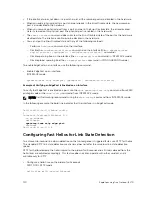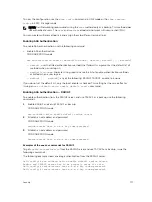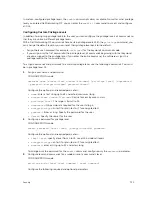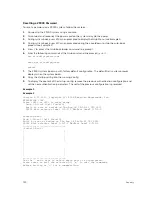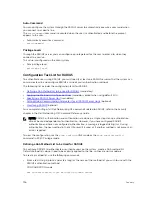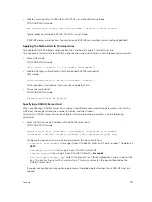
To use local authentication for
enable secret
on the console, while using remote authentication on
VTY lines, issue the following commands.
The following example shows enabling local authentication for console and remote authentication for
the VTY lines.
Dell(config)# aaa authentication enable mymethodlist radius tacacs
Dell(config)# line vty 0 9
Dell(config-line-vty)# enable authentication mymethodlist
Server-Side Configuration
•
— When using , Dell Networking sends an initial packet with service type
SVC_ENABLE, and then sends a second packet with just the password. The TACACS server must have
an entry for username $enable$.
•
RADIUS
— When using RADIUS authentication, FTOS sends an authentication packet with the
following:
Username: $enab15$
Password: <password-entered-by-user>
Therefore, the RADIUS server must have an entry for this username.
Obscuring Passwords and Keys
By default, the
service password-encryption
command stores encrypted passwords. For greater
security, you can also use the
service obscure-passwords
command to prevent a user from reading
the passwords and keys, including RADIUS, keys, router authentication strings, VRRP
authentication by obscuring this information. Passwords and keys are stored encrypted in the
configuration file and by default are displayed in the encrypted form when the configuration is displayed.
Enabling the
service obscure-passwords
command displays asterisks instead of the encrypted
passwords and keys. This command prevents a user from reading these passwords and keys by obscuring
this information with asterisks.
Password obscuring masks the password and keys for display only but does not change the contents of
the file. The string of asterisks is the same length as the encrypted string for that line of configuration. To
verify that you have successfully obscured passwords and keys, use the
show running-config
command or
show startup-config
command.
If you are using role-based access control (RBAC), only the system administrator and security
administrator roles can enable the
service obscure-password
command.
To enable the obscuring of passwords and keys, use the following command.
• Turn on the obscuring of passwords and keys in the configuration.
CONFIGURATION mode
service obscure-passwords
Example of Obscuring Password and Keys
Dell(config)# service obscure-passwords
718
Security
Summary of Contents for Z9000
Page 1: ...Dell Configuration Guide for the Z9000 System 9 7 0 0 ...
Page 80: ...grub reboot 80 Management ...
Page 128: ... 0 Te 1 1 Te 1 2 rx Flow N A N A 128 Access Control Lists ACLs ...
Page 491: ...Figure 70 Configuring OSPF and BGP for MSDP Multicast Source Discovery Protocol MSDP 491 ...
Page 496: ...Figure 73 MSDP Default Peer Scenario 1 496 Multicast Source Discovery Protocol MSDP ...
Page 497: ...Figure 74 MSDP Default Peer Scenario 2 Multicast Source Discovery Protocol MSDP 497 ...
Page 498: ...Figure 75 MSDP Default Peer Scenario 3 498 Multicast Source Discovery Protocol MSDP ...
Page 760: ...Figure 100 Single and Double Tag TPID Match 760 Service Provider Bridging ...
Page 761: ...Figure 101 Single and Double Tag First byte TPID Match Service Provider Bridging 761 ...







